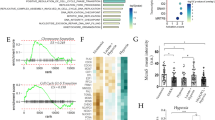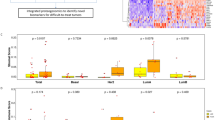Abstract
Purpose
Oxidative stress-responsive kinase 1 (OSR1) plays a crucial role in regulating diverse cellular pathophysiologic functions, including ion homeostasis, development, differentiation, angiogenesis, invasive migration, and metastasis. Regardless, the clinical significance of OSR1 in breast cancer is scarce. The current study was conducted to evaluate the effect of OSR1 on the prognosis of patients with breast cancer with a long-term follow-up.
Methods
OSR1 expression in formalin-fixed and paraffin-embedded tissue specimens was analyzed. These specimens were collected from 551 evaluable breast cancer cases by immunohistochemistry (IHC). OSR1 expression was dichotomized based on the H-score in IHC. The effects of OSR1 levels on the clinicopathological attributes and survival prediction in patients with breast cancer were explored.
Results
Among 551 specimens, 183 (33.2%) exhibited high expression of OSR1 in tumor cells. High OSR1 levels were markedly correlated with histologic grade (P = 0.035), ER (P < 0.001) and PgR (P = 0.043) expression, lymph node involvement (P < 0.001), TNM stage (P < 0.001), and axillary surgery procedures (P = 0.003). Univariate analysis results indicate that patients with high OSR1 expression had significantly poor overall survival (P < 0.001), distant disease-free survival (P < 0.001), and breast cancer-specific survival (P < 0.001). Multivariable Cox regression analyses suggest that OSR1 expression was an independent predictive marker of poor prognosis and lymph node metastasis (HR 3.224, 95% CI 1.182–8.702, P = 0.023) in patients with breast cancer.
Conclusions
Our findings indicate that OSR1 is a significantly independent prognosis index for patients with breast cancer with respect to distant disease-free survival, overall survival, and breast cancer-specific survival. High OSR1 expression caused an increase in deaths specifically attributed to breast cancer and was related to increased lymph node metastasis. However, the precise cellular mechanisms for OSR1 in breast cancer require further research.



Similar content being viewed by others
References
Gorbounov M, Carleton NM, Asch-Kendrick RJ, Xian L, Rooper L, Chia L, Cimino-Mathews A, Cope L, Meeker A, Stearns V, Veltri RW, Bae YK, Resar LMS (2019) High mobility group A1 (HMGA1) protein and gene expression correlate with ER-negativity and poor outcomes in breast cancer. Breast Cancer Res Treat. https://doi.org/10.1007/s10549-019-05419-1
Siegel RL, Miller KD, Jemal A (2019) Cancer statistics, 2019. CA Cancer J Clin 69:7–34. https://doi.org/10.3322/caac.21551
Wu Q, Li J, Sun S, Zhu S, Chen C, Wu J, Liu Q, Wei W, Sun S (2017) Breast carcinoma in situ: an observational study of tumor subtype treatment and outcomes. Oncotarget 8:2361–2371. https://doi.org/10.18632/oncotarget.13785
Tamari M, Daigo Y, Nakamura Y (1999) Isolation and characterization of a novel serine threonine kinase gene on chromosome 3p22-21.3. J Hum Genet 44:116–120. https://doi.org/10.1007/s100380050121
Pedro NF, Biselli JM, Maniglia JV, de Santi-Neto D, Pavarino ÉC, Goloni-Bertollo EM, Biselli-Chicote PM (2018) Candidate biomarkers for oral squamous cell carcinoma: differential expression of oxidative stress-related genes. APJCP 19:1343. https://doi.org/10.22034/APJCP.2018.19.5.1343
Piechotta K, Lu J, Delpire E (2002) Cation chloride cotransporters interact with the stress-related kinases Ste20-related proline-alanine-rich kinase (SPAK) and oxidative stress response 1 (OSR1). J Biol Chem 277:50812–50819. https://doi.org/10.1074/jbc.m208108200
Mazorra Z, Popa X, Garcia B, Huerta V, Viada C, Neninger E, Rodriguez P, Gonzalez Z, Gonzalez A, Crombet T (2018) PO-486 Surrogate biomarkers of clinical efficacy in stage IIIB/IV non-small-cell lung cancer patients treated with an optimised EGF-based vaccination schedule. BMJ Publishing Group Limited, London
Tahmasbpour E, Ghanei M, Qazvini A, Vahedi E, Panahi Y (2016) Gene expression profile of oxidative stress and antioxidant defense in lung tissue of patients exposed to sulfur mustard. Mutat Res Genet Toxicol Environ Mutagen 800:12–21. https://doi.org/10.1016/j.mrgentox.2016.03.006
Gallolu Kankanamalage S, Lee A-Y, Wichaidit C, Lorente-Rodriguez A, Shah AM, Stippec S, Whitehurst AW, Cobb MH (2017) WNK1 is an unexpected autophagy inhibitor. Autophagy 13:969–970. https://doi.org/10.1080/15548627.2017.1286431
Burington B, Barlogie B, Zhan F, Crowley J, Shaughnessy JD (2008) Tumor cell gene expression changes following short-term in vivo exposure to single agent chemotherapeutics are related to survival in multiple myeloma. Clin Cancer Res 14:4821–4829. https://doi.org/10.1158/1078-0432.ccr-07-4568
Rauch TA, Wang Z, Wu X, Kernstine KH, Riggs AD, Pfeifer GP (2012) DNA methylation biomarkers for lung cancer. Tumor Biol 33:287–296. https://doi.org/10.1016/b978-0-12-801899-6.00013-9
Selvan L, Danda R, Madugundu A, Puttamallesh V, Sathe G, Krishnan U, Khetan V, Rishi P, Prasad T, Pandey A (2018) Phosphoproteomics of retinoblastoma: a pilot study identifies aberrant kinases. Molecules 23:1454. https://doi.org/10.3390/molecules23061454
Treiber JM, Steed TC, Brandel MG, Patel KS, Dale AM, Carter BS, Chen CC (2018) Molecular physiology of contrast enhancement in glioblastomas: an analysis of the cancer imaging archive (TCIA). J Clin Neurosci 55:86–92. https://doi.org/10.1016/j.jocn.2018.06.018
Both J, Krijgsman O, Bras J, Schaap GR, Baas F, Ylstra B, Hulsebos TJ (2014) Focal chromosomal copy number aberrations identify CMTM8 and GPR177 as new candidate driver genes in osteosarcoma. PLoS ONE 9:e115835. https://doi.org/10.1371/journal.pone.0115835
Anselmo AN, Earnest S, Chen W, Juang Y-C, Kim SC, Zhao Y, Cobb MH (2006) WNK1 and OSR1 regulate the Na+, K+, 2Cl− cotransporter in HeLa cells. Proc Natl Acad Sci 103:10883–10888. https://doi.org/10.1073/pnas.0604607103
Zhu W, Begum G, Pointer K, Clark PA, Yang S-S, Lin S-H, Kahle KT, Kuo JS, Sun D (2014) WNK1-OSR1 kinase-mediated phospho-activation of Na+-K+-2Cl− cotransporter facilitates glioma migration. Mol Cancer 13:31. https://doi.org/10.1186/1476-4598-13-31
Du E, Lu C, Sheng F, Li C, Li H, Ding N, Chen Y, Zhang T, Yang K, Xu Y (2018) Analysis of potential genes associated with primary cilia in bladder cancer. Cancer Manag Res 10:3047. https://doi.org/10.2147/cmar.s175419
Hortobagyi GN, Connolly JL, D'Orsi CJ, Edge SB, Mittendorf EA, Rugo HS, Solin LJ, Weaver DL, Winchester DJ, Giuliano AE (2017) American Joint Committee on Cancer (AJCC). AJCC cncer staging manual, 8th edn. Springer, Chicago
Giuliano AE, Connolly JL, Edge SB, Mittendorf EA, Rugo HS, Solin LJ, Weaver DL, Winchester DJ, Hortobagyi GN (2017) Breast cancer-major changes in the American Joint Committee on Cancer eighth edition cancer staging manual. CA Cancer J Clin 67:290–303. https://doi.org/10.3322/caac.21393
Grunkin M, Raundahl J, Foged NT (2011) Practical considerations of image analysis and quantification of signal transduction IHC staining. Signal Transduction Immunohistochemistry. Springer, New York, pp 143–154
Thompson AM, Jordan LB, Quinlan P, Anderson E, Skene A, Dewar JA, Purdie CA (2010) Prospective comparison of switches in biomarker status between primary and recurrent breast cancer: the Breast Recurrence In Tissues Study (BRITS). Breast Cancer Res 12:R92. https://doi.org/10.1186/bcr2771
Wilking U, Karlsson E, Skoog L, Hatschek T, Lidbrink E, Elmberger G, Johansson H, Lindström L, Bergh J (2011) HER2 status in a population-derived breast cancer cohort: discordances during tumor progression. Breast Cancer Res Treat 125:553–561. https://doi.org/10.1007/s10549-010-1029-2
Lindström LS, Karlsson E, Wilking UM, Johansson U, Hartman J, Lidbrink EK, Hatschek T, Skoog L, Bergh J (2012) Clinically used breast cancer markers such as estrogen receptor, progesterone receptor, and human epidermal growth factor receptor 2 are unstable throughout tumor progression. J Clin Oncol 30:2601–2608. https://doi.org/10.1200/jco.2011.37.2482
Engstrøm MJ, Valla M, Bofin AM (2017) Basal markers and prognosis in luminal breast cancer. Breast Cancer Res Treat 163:207–217. https://doi.org/10.1007/s10549-017-4182-z
Delpire E, Gagnon KB (2006) SPAK and OSR1, key kinases involved in the regulation of chloride transport. Acta Physiol 187:103–113. https://doi.org/10.1111/j.1748-1716.2006.01565.x
Zavagno G, De Salvo GL, Scalco G, Bozza F, Barutta L, Del Bianco P, Renier M, Racano C, Carraro P, Nitti D (2008) A randomized clinical trial on sentinel lymph node biopsy versus axillary lymph node dissection in breast cancer: results of the Sentinella/GIVOM trial. Ann Surg 247:207–213. https://doi.org/10.1097/sla.0b013e31812e6a73
Conti A, Luchini A, Benassi MS, Magagnoli G, Pierini M, Piccinni-Leopardi M, Quattrini I, Pollino S, Picci P, Liotta LA (2018) Circulating candidate biomarkers in giant cell tumors of bone. Proteom Clin Appl 12:1800041. https://doi.org/10.1002/prca.201800041
Goldhirsch A, Winer EP, Coates A, Gelber R, Piccart-Gebhart M, Thürlimann B, Senn H-J, Members P, Albain KS, André F (2013) Personalizing the treatment of women with early breast cancer: highlights of the St Gallen International Expert Consensus on the Primary Therapy of Early Breast Cancer 2013. Ann Oncol 24:2206–2223. https://doi.org/10.1159/000351222
Group EBCTC (2011) Effect of radiotherapy after breast-conserving surgery on 10-year recurrence and 15-year breast cancer death: meta-analysis of individual patient data for 10,801 women in 17 randomised trials. Lancet 378:1707–1716. https://doi.org/10.1016/j.breastdis.2012.06.011
Villa F, Goebel J, Rafiqi FH, Deak M, Thastrup J, Alessi DR, van Aalten DM (2007) Structural insights into the recognition of substrates and activators by the OSR1 kinase. EMBO Rep 8:839–845. https://doi.org/10.2210/pdb2v3s/pdb
Stossel TP (1993) On the crawling of animal cells. Science 260:1086–1094. https://doi.org/10.1126/science.8493552
Gagnon KB, Rios K, Delpire E (2011) Functional insights into the activation mechanism of Ste20-related kinases. Cell Physiol Biochem 28:1219–1230. https://doi.org/10.1159/000335854
Chen W, Yazicioglu M, Cobb MH (2004) Characterization of OSR1, a member of the mammalian Ste20p/germinal center kinase subfamily. J Biol Chem 279:11129–11136. https://doi.org/10.1074/jbc.m313562200
Papakonstanti EA, Stournaras C (2002) Association of PI-3 kinase with PAK1 leads to actin phosphorylation and cytoskeletal reorganization. Mol Biol Cell 13:2946–2962. https://doi.org/10.1091/mbc.02-01-0599
Locksley RM, Killeen N, Lenardo MJ (2001) The TNF and TNF receptor superfamilies: integrating mammalian biology. Cell 104:487–501. https://doi.org/10.1016/s0092-8674(01)00237-9
Cusick JK, Xu L-G, Bin L-H, Han K-J, Shu H-B (2006) Identification of RELT homologues that associate with RELT and are phosphorylated by OSR1. Biochem Biophys Res Commun 340:535–543. https://doi.org/10.1016/j.bbrc.2005.12.033
Barrios-Rodiles M, Brown KR, Ozdamar B, Bose R, Liu Z, Donovan RS, Shinjo F, Liu Y, Dembowy J, Taylor IW (2005) High-throughput mapping of a dynamic signaling network in mammalian cells. Science 307:1621–1625. https://doi.org/10.1126/science.1105776
Stransky N, Vallot C, Reyal F, Bernard-Pierrot I, De Medina SGD, Segraves R, De Rycke Y, Elvin P, Cassidy A, Spraggon C (2006) Regional copy number–independent deregulation of transcription in cancer. Nat Genet 38:1386. https://doi.org/10.1038/ng1923
Acknowledgements
This study was supported by the National Natural Science Foundation of China (81670595, 81970568) and Excellent Youth Medical Talents Program of Shanghai General Hospital (06N1702011).
Author information
Authors and Affiliations
Corresponding author
Ethics declarations
Conflicts of interest
All authors declare that they have no conflict of interest or other disclosures.
Ethical approval
All procedures performed in studies involving human participants were in accordance with the ethical standards of the institutional and/or national research committee and with the 1964 Helsinki declaration and its later amendments or comparable ethical standards. This article does not contain any studies with animals performed by any of the authors. The research protocol was reviewed and authorized by the Ethics Committee of the Shanghai General Hospital, Shanghai Jiao Tong University School of Medicine.
Informed consent
Informed consent was obtained from all individual participants included in the study.
Additional information
Publisher's Note
Springer Nature remains neutral with regard to jurisdictional claims in published maps and institutional affiliations.
Rights and permissions
About this article
Cite this article
Li, Y., Qin, J., Wu, J. et al. High expression of OSR1 as a predictive biomarker for poor prognosis and lymph node metastasis in breast cancer. Breast Cancer Res Treat 182, 35–46 (2020). https://doi.org/10.1007/s10549-020-05671-w
Received:
Accepted:
Published:
Issue Date:
DOI: https://doi.org/10.1007/s10549-020-05671-w




